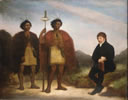Missionaries
Formal study of Māori language and cultural traditions began through the efforts of early missionaries to communicate with Māori in order to convert them to Christianity.
Thomas Kendall of the Anglican Church Missionary Society (CMS), one of the first three missionaries to settle in New Zealand, published the first book in Māori in 1815: A korao [kōrero] no New Zealand; or, the New Zealander's first book; being an attempt to compose some lessons for the instruction of the natives. In 1820 he and the chiefs Hongi Hika and Waikato visited England to work with Cambridge University linguist Samuel Lee to produce the first Grammar and vocabulary of the language of New Zealand. Kendall, after being dismissed as a missionary, lived with Tūngaroa, the daughter of Rākau, a tohunga of Rangihoua in the Bay of Islands. Through this connection he wrote an account of Māori cosmological thought, describing the symbolic significance of traditional carvings.
The richness of te reo
Many early missionaries to New Zealand had studied languages such as Greek and Latin, and readily appreciated the regular grammar and complex vocabulary of Māori. Missionary William Yate wrote, ‘The language is peculiarly soft and sweet, and in the longest speeches not a harsh sound ever strikes the ear … the language of New Zealand is remarkably rich, admits of a very varied phraseology, abounds in terms of peculiar nicety, and is capable of being reduced to the most precise grammatical principles.’1
French Catholic missionary Louis Servant also wrote a detailed and valuable account of early Māori society, published in English translation in 1973 as Customs and habits of the New Zealanders. Another CMS missionary (and later bishop), William Williams, published the first substantial Māori-to-English dictionary in 1844. Later editions were produced by his son and grandson, also Anglican bishops.
Te Rangikāheke
The first professional teacher of Māori studies was probably Wiremu Te Rangikāheke, a mission-educated scholar from the Ngāti Rangiwewehi tribe of Rotorua. From 1849 he worked closely with Governor George Grey, teaching him Māori language and customs. At times Te Rangikāheke was paid £36 a year, plus accommodation for himself and his family. He produced a large number of Māori-language manuscripts on most aspects of Māori culture, and contributed to Grey's manuscripts of songs and proverbs, including Ko nga moteatea, me nga hakirara o nga Maori (1853), and Ko nga mahinga a nga tupuna Maori (1854), and its English translation, Polynesian mythology (1855).
The Polynesian Society
In 1892 Stephenson Percy Smith and Edward Tregear, both senior civil servants and amateur scholars of Māori language, history and traditions, co-founded the Polynesian Society to study New Zealand Māori and other Pacific Island peoples and their cultures, past and present. Smith recruited a number of distinguished Māori as members, including Apirana Ngata, Māui Pōmare and Te Rangi Hīroa (Peter Buck). All three had been trained in western systems of knowledge (Pōmare and Te Rangi Hīroa as doctors, and Ngata as a lawyer) and also in the traditional lore of their people. Te Rangi Hīroa eventually became a professor of anthropology at Yale University in the United States, and director of Hawaii’s Bishop ethnological museum.
The Journal of the Polynesian Society, published since 1892 (and still published in 2019), has been edited by leading figures in Māori studies, such as the self-taught ethnologist Elsdon Best. The society has also published important collections of traditional literature, including Ngata's collection of waiata, Ngā mōteatea (1928), and a new edition of George Grey’s Nga mahi a nga tupuna (1928).
Maggie Papakura
Mākereti Papakura, also known as Guide Maggie Papakura, of Te Arawa and English parentage, studied anthropology at Oxford University from 1926 to her death in 1930. Her thesis was published in 1938 as The old-time Maori, and was the first major publication by a Māori ethnologist.










